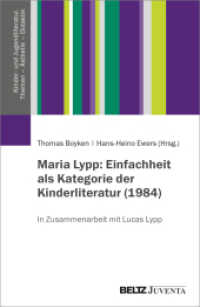- ホーム
- > 洋書
- > ドイツ書
- > Humanities, Arts & Music
- > History
- > 20th century (1914-1955/49)
Description
(Text)
More than a century after the beginning of the quantum revolution, historians continue to explore new facets in the history of quantum physics, and to re-examine some of its better- known aspects. The thirteen papers collected in this volume, by authors from five continents, present central trends in the current study of quantum physics within its theoretical, experimental, philosophical, technological and social contexts. They discuss developments from the late nineteenth to the early twenty-first century and go beyond the traditional focus on Europe and North America to include China and Japan, and beyond the Heisenbergs and Diracs to reveal the role of actors who hitherto have played only a marginal role in historical account, but left their mark on the development of quantum physics. Also a wider array of subdisciplines comes into view, from optics to quantum gravity through quantum electrodynamics, from atomic and nuclear to condense matter physics and foundations of physics. Moreover, the volume shows that fields such as dispersion, physical chemistry and solid state physics should not be seen merely as areas of applications of ideas that evolved in other contexts, but should be regarded as birthplaces of important theoretical insights. The perspective of the papers ranges from local histories to global discussions, from conceptual changes via the role of experimentation to interactions with social and technological forces and to the interpretation of the theory. --- The series 'Proceedings' of the Max Planck Research Library for the History and Development of Knowledge presents the results of scientific meetings on current issues and supports further cooperation on these issues via an electronic platform. The volumes are available both as print-on-demand books and as open-access publications on the Internet. The material is freely accessible online at www.edtion-open-access.de, supplemented by additional information and interactive features. The original scholarly work presented in these volumes is published under the responsibility of designated members of the Scientific Board and their appointed reviewers.
(Table of content)
Contributors
Introduction
From Classical to Quantum Physics
Theoretical Challenges by Experimental Physics: Radiation and Its Interaction with Matter (Shaul Katzir)
Challenging the Boundaries between Classical and Quantum Physics: The Case of Optical Dispersion (Marta Jordi Taltavull)
Putting the Quantum to Work: Otto Sackur's Pioneering Exploits in the Quantum Theory of Gases (Massimiliano Badino and Bretislav Friedrich)
Quantum Mechanics in the Making
The Concepts of Light Atoms and Light Molecules and Their Final Interpretation (Dieter Fick and Horst Kant)
Early Interactions of Quantum Statistics and Quantum Mechanics (Daniela Monaldi)
Pourparlers for Amalgamation: Some Early Sources of Quantum Gravity Research (Dean Rickles)
Extending the Framework of Quantum Physics
Superposing Dynamos and Electrons: Electrical Engineering and Quantum Physics in the Case of Nishina Yoshio (Kenji Ito)
The Origins of Maria Göppert's Dissertation on Two-Photon Quantum Transitions at Göttingen's Institutes of Physics 1920-1933 (Barry R. Masters)
An Act of Creation: The Meitner-Frisch Interpretation of Nuclear Fission (Roger H. Stuewer)
The Challenges of Quantum Field Theory
Tsung-Sui Chang's Contribution to the Quantization of Constrained Hamiltonian Systems (Xiaodong Yin, Zhongyuan Zhu and Donald C. Salisbury)
Feynman's Struggle and Dyson's Surprise: The Development and Early Application of a New Means of Representation (Adrian Wüthrich)
Traditions and Debates in Recent Quantum Physics
Orthodoxies on the Interpretation of Quantum Theory: The Case of the Consistent History Approach (Olival Freire)
From Do-it-yourself Quantum Mechanics to Nanotechnology? The History of Experimental Semiconductor Physics, 1970-2000 (Christian Kehrt)








